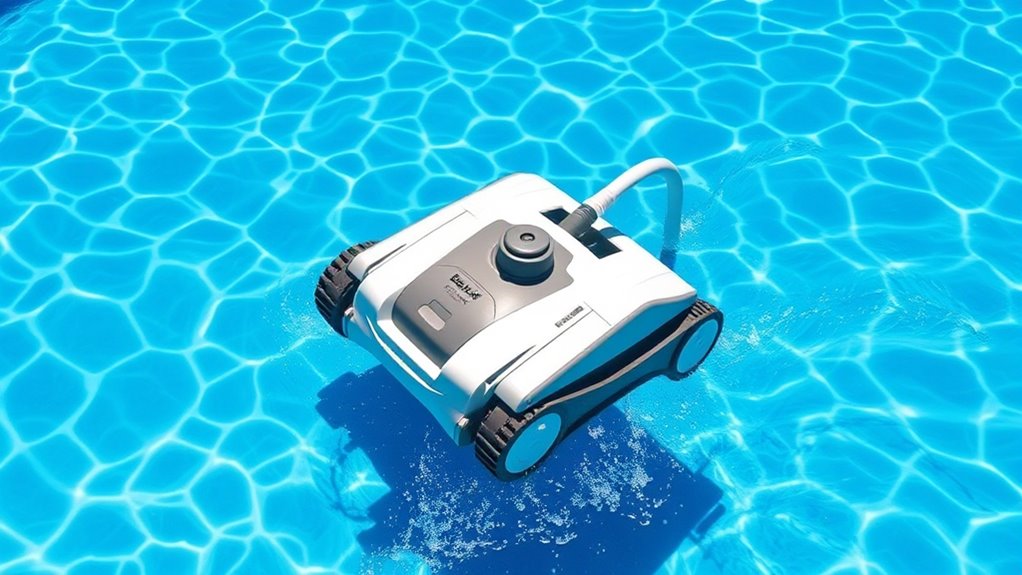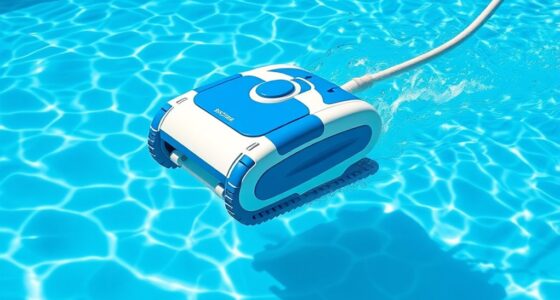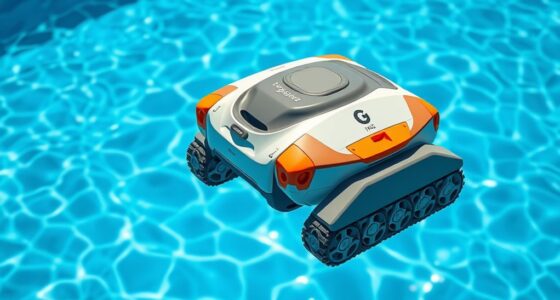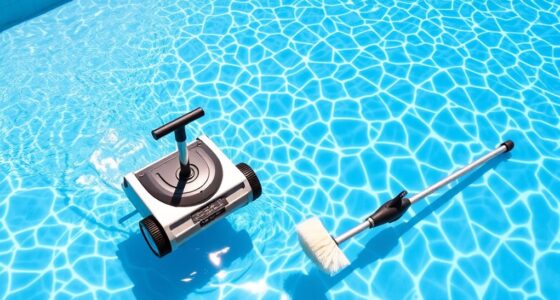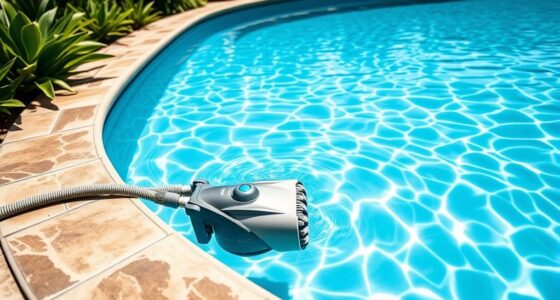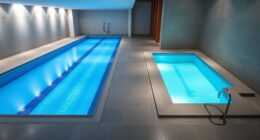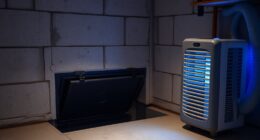Pressure pool cleaners work by using water pressure from a dedicated pump to power internal mechanisms that move across your pool’s surface and collect debris. The pump pushes water through hoses and jets, which propel the cleaner and direct debris into filters or chambers. They navigate automatically, covering the entire area efficiently. Maintaining components and understanding how these systems operate can help you optimize your pool’s cleanliness — keep exploring for more details.
Key Takeaways
- Pressure pool cleaners use water forced by a pump to propel themselves and move across the pool surface.
- They connect to the pool’s existing pump and filter system to operate continuously.
- Water jets lift debris into the cleaner’s filter chambers for collection and filtration.
- Integrated sensors and algorithms help navigate obstacles and ensure thorough coverage.
- Regular maintenance of filters, hoses, and components ensures optimal cleaning performance.
Components of a Pressure Pool Cleaner
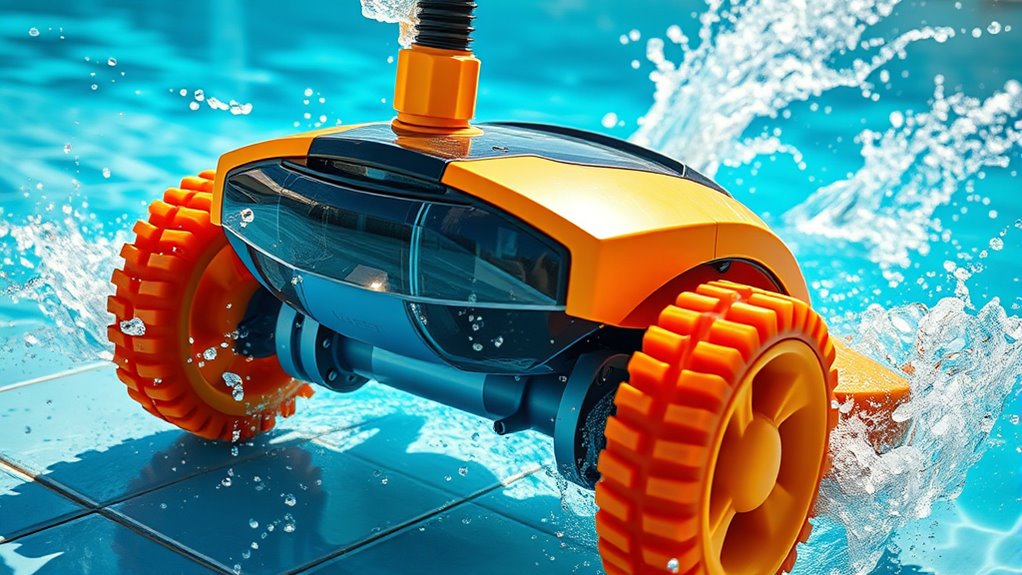
A pressure pool cleaner relies on several key components working together to effectively clean your pool. One vital element is the skimmer basket design, which captures debris before it enters the pump, helping maintain proper water flow and preventing clogs. A well-designed skimmer basket makes cleaning easier and ensures the cleaner operates smoothly. Additionally, maintaining proper pool chemical balance is essential; if your water isn’t balanced, debris can accumulate faster, and the cleaner’s performance may decline. The cleaner’s hoses, jets, and internal mechanisms work in tandem, but without a properly functioning skimmer basket and balanced chemicals, their efficiency drops. Proper pool maintenance and regular inspection of components are crucial for optimal operation. These components form the foundation for effective cleaning, keeping your pool clear and healthy with less effort on your part. Regular maintenance of the skimmer basket and monitoring water chemistry can significantly enhance the cleaner’s lifespan and performance.
How Water Pressure Is Generated and Used
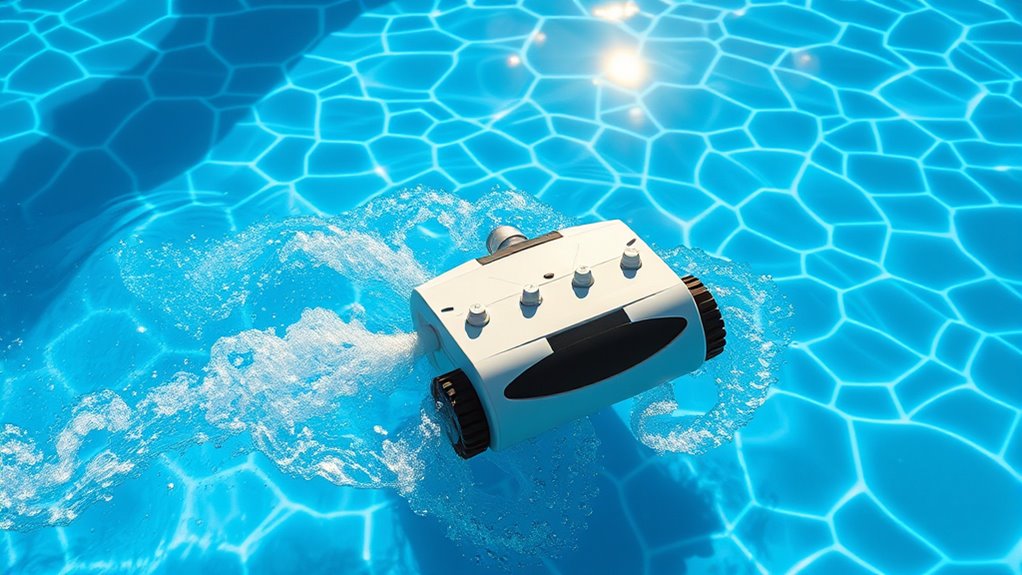
Water pressure in a pressure pool cleaner is generated by the pump, which forces water through hoses and jets to propel the cleaner along the pool surface. The pump’s efficiency directly affects water pressure, influencing cleaning performance. When the pump operates effectively, it produces consistent water pressure, ensuring the jets push debris efficiently. If pump efficiency drops, water pressure decreases, reducing cleaning power. To maximize performance, regularly check the pump and adjust settings as needed. Proper maintenance of components like the water pump can help sustain high efficiency and ensure the cleaner functions effectively. Additionally, ensuring the reservoir system is properly maintained and functioning correctly contributes to optimal water pressure and overall cleaning effectiveness. Understanding the comparative advantage of maintaining equipment can lead to better resource allocation and longer-lasting components. Maintaining proper water flow also helps prevent clogged jets, which can hinder cleaning efficacy and reduce overall performance. Regular inspection of hoses and connections can further prevent leaks that diminish water pressure and cleaning efficiency.
Movement and Navigation Mechanisms
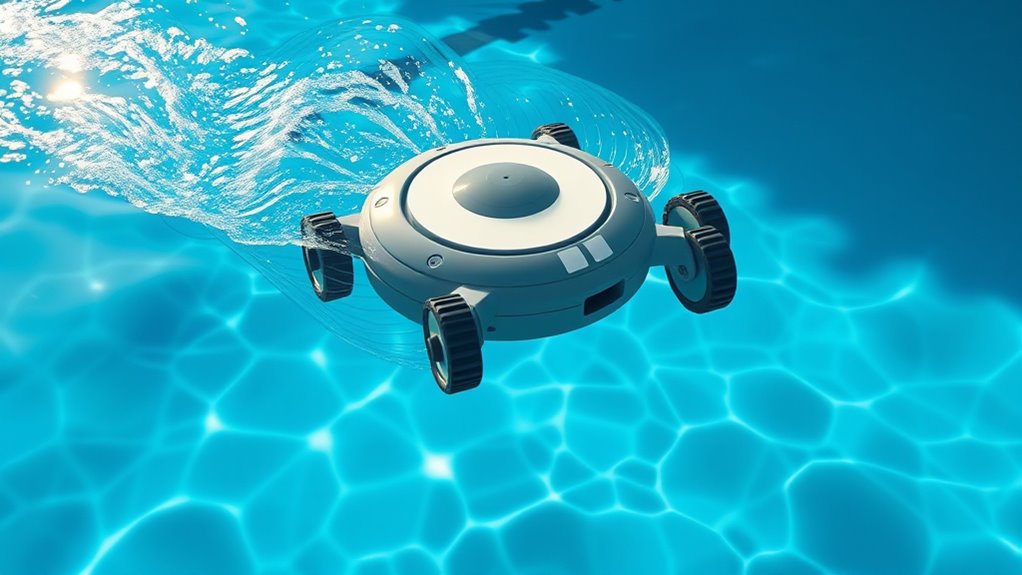
You’ll notice that pressure pool cleaners use water flow control to steer and move efficiently across the pool surface. They often rely on advanced pathfinding techniques to navigate around obstacles and cover the entire area. Understanding these mechanisms helps you appreciate how they operate smoothly and thoroughly. Additionally, some models incorporate integration with pool systems to optimize their operation and coordinate with other equipment. The design of these cleaners often includes smart features, which can enhance navigation and efficiency further.
Water Flow Control
Effective water flow control is essential for guaranteeing pressure pool cleaners navigate efficiently and cover the entire pool surface. By regulating water pressure, these cleaners can adjust their movement patterns, preventing missed spots. Maintaining proper pool chemical balance ensures ideal water flow, which helps the cleaner function smoothly. Solar heating can influence water temperature, affecting water viscosity and flow rate, so adjusting flow control ensures consistent cleaning regardless of temperature changes. Valves and flow regulators allow you to direct water precisely, improving navigation and coverage. Proper water flow control also minimizes strain on the cleaner’s motor and components, extending its lifespan. Additionally, incorporating pressure regulation enhances overall system performance by preventing fluctuations that could hinder cleaning efficiency. Proper water flow management is crucial for optimizing cleaning performance and conserving energy. By fine-tuning the water flow, you maximize the cleaner’s performance, ensuring a thorough and efficient cleaning process. Furthermore, hybrid bicycle features such as adjustable components can serve as a useful analogy for understanding how precise adjustments in flow control can optimize cleaning outcomes. Implementing advanced control systems can further refine water flow, leading to more consistent and reliable cleaning results. For example, integrating feedback mechanisms can help monitor and adapt flow in real-time for optimal operation.
Pathfinding Techniques
Pathfinding techniques are essential for guaranteeing pressure pool cleaners navigate efficiently and thoroughly cover the entire pool surface. These cleaners use algorithms that enable them to detect obstacles, edges, and previously cleaned areas, optimizing their movement patterns. By employing random or systematic paths, they reduce missed spots and improve cleaning coverage. Understanding your pool cleaning schedule helps you choose a cleaner with effective pathfinding, ensuring each session is thorough without unnecessary repetitions. Additionally, efficient pathfinding minimizes energy consumption considerations, making the cleaner more eco-friendly and cost-effective. Advanced models may incorporate sensors or mapping technologies to adapt their routes dynamically, maximizing coverage and limiting energy use. Proper pathfinding ensures a cleaner that’s both effective and energy-efficient, saving you time and money. Incorporating navigation technology can further enhance the efficiency of pressure pool cleaners by allowing real-time route adjustments based on the pool’s layout. Recognizing the importance of efficient algorithms can lead to better performance and longer lifespan of your pool cleaner. Additionally, some models utilize sensor-based detection to improve obstacle avoidance and route optimization. Moreover, understanding the different pathfinding methods can help you select a model that best suits your pool’s unique shape and size. Moreover, staying informed about advancements in pool cleaning technology can help you choose the most effective and innovative models available.
Debris Collection and Filtration Process
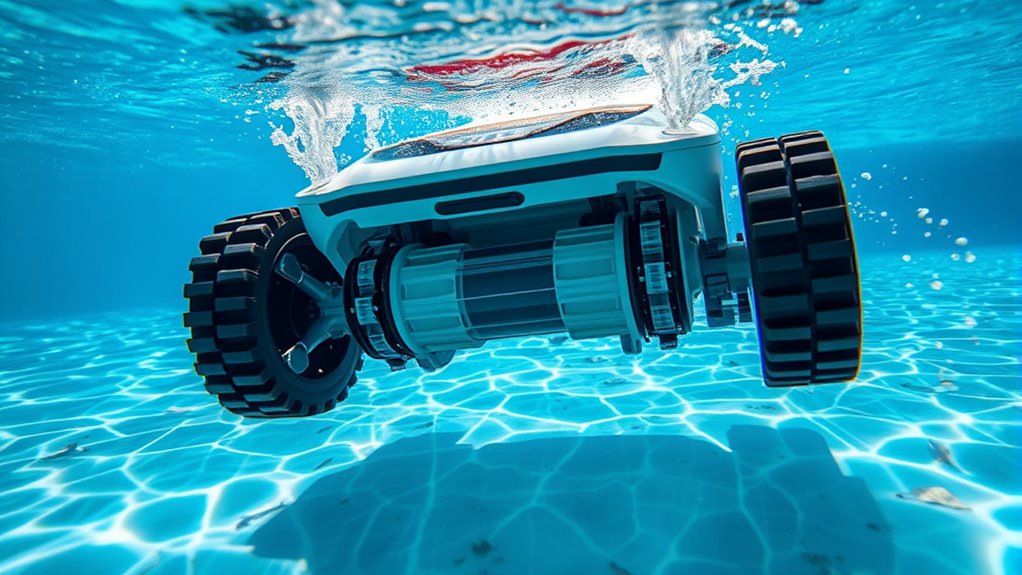
Pressure pool cleaners rely on a powerful jet of water to lift debris from the pool floor and walls, directing it toward their filtration system. Their robotic navigation guarantees they move systematically, covering the entire surface and improving cleaning efficiency. As debris is loosened, it travels through a series of hoses and filters within the cleaner. Fine particles are captured by the filter bag or cartridge, preventing clogs and keeping the water clear. Larger debris, like leaves and twigs, are pushed into the filter chamber for easy removal. The continuous circulation of water helps maintain clear, healthy pool water while the debris is effectively collected and filtered, ensuring your pool stays clean with minimal effort. Understanding industry trends helps manufacturers improve their filtering technology for better performance and innovation in AI-powered cleaning technology.
Advantages of Using Pressure Pool Cleaners
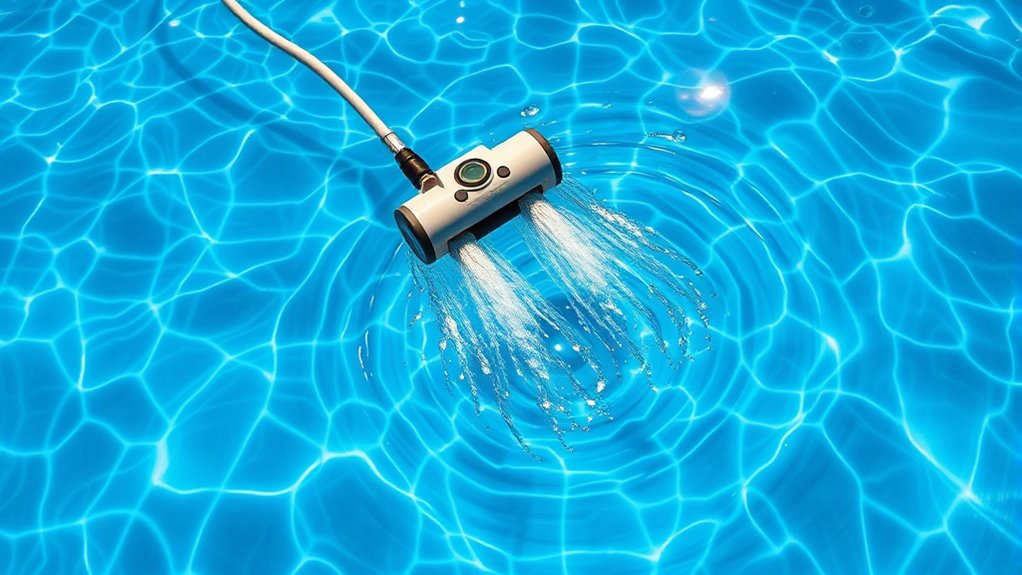
Using pressure pool cleaners offers several advantages that make maintaining your pool easier and more efficient. One key benefit is improved pool cleaning efficiency, as these cleaners cover large areas quickly and reach difficult spots like corners and steps. They operate continuously, reducing manual effort and ensuring your pool stays cleaner with less oversight. Additionally, pressure pool cleaners are generally durable and easy to set up, saving you time and hassle. When considering energy consumption, these cleaners tend to be more energy-efficient than some robotic models because they use existing pool equipment, like your pump and filter system. This setup helps minimize additional power use while maximizing cleaning performance. Overall, pressure pool cleaners simplify maintenance and help keep your pool pristine with less effort and smarter energy use.
Maintenance and Troubleshooting Tips
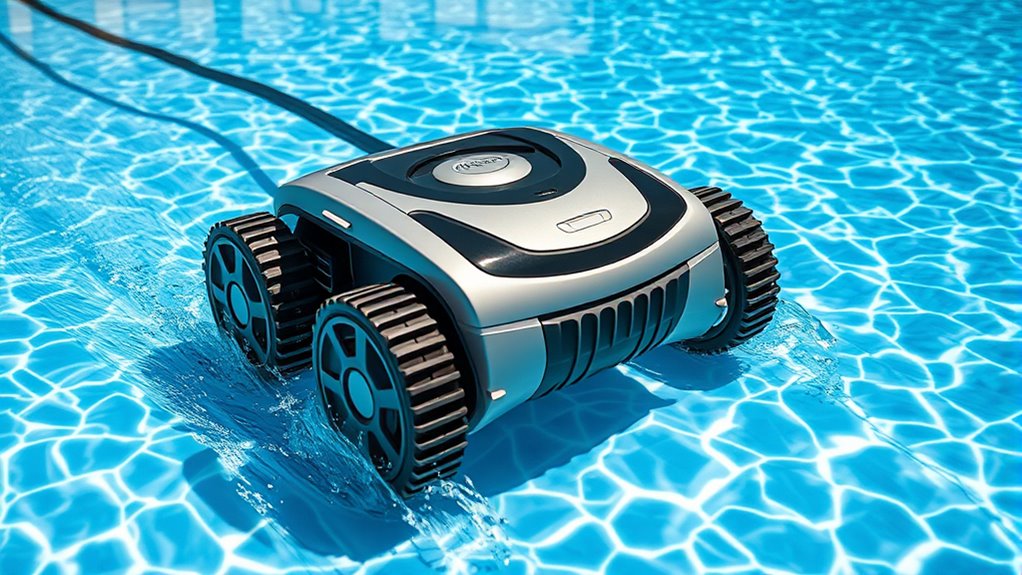
Regular maintenance is key to keeping your pressure pool cleaner operating at peak performance. Start by inspecting and performing filter maintenance regularly; clean or replace the filter as needed to ensure proper suction and debris removal. A clogged filter can reduce effectiveness and strain the motor. If your cleaner isn’t moving properly or making unusual noises, it’s time for motor troubleshooting. Check for obstructions, loose connections, or worn-out parts. Ensure the hoses are free of leaks and connections are tight. Regularly inspect the brushes and wheels for wear and replace them if necessary. Keeping your equipment clean and well-maintained prevents breakdowns and extends its lifespan. Following these tips helps your pressure pool cleaner work efficiently, saving you time and effort in pool maintenance.
Frequently Asked Questions
Can Pressure Pool Cleaners Handle Large Debris Like Sticks?
Pressure pool cleaners can typically handle some large debris like sticks, but it depends on their debris capacity and design. If the cleaner’s debris capacity is limited, large sticks might cause debris blockage, preventing the cleaner from functioning properly. To prevent issues, regularly check for debris blockage and empty the debris chamber as needed. For frequent large debris, consider a cleaner designed specifically for heavy-duty debris pickup.
How Long Does a Typical Pressure Pool Cleaning Cycle Take?
Most pressure pool cleaners complete a cycle in about 3 to 4 hours, depending on pool size and debris level. You should incorporate regular cleaning schedules and maintenance routines to keep your pool pristine. These cleaners work efficiently, saving you time and effort. Knowing your cleaner’s cycle length helps you plan better, ensuring your pool remains clean and ready for use without disrupting your daily routine.
Are Pressure Pool Cleaners Suitable for All Pool Shapes and Sizes?
Pressure pool cleaners are generally suitable for most pool shapes, but you should check for pool shape compatibility to guarantee they work efficiently. They handle various pool sizes, but large pools might take longer to clean fully due to pool size limitations. If you have an unusual shape or a very small or large pool, consider a model specifically designed for your pool size and shape for the best results.
Do Pressure Pool Cleaners Require Any Special Installation?
You’ll find that pressure pool cleaners generally don’t require complex installation. Most models connect easily to your existing pool equipment, with simple setup steps. Just guarantee your pool’s plumbing matches the installation requirements, and check for secure fittings. Regular maintenance tips include inspecting hoses for leaks and cleaning filters. By following these steps, you’ll keep your pressure cleaner running smoothly and effectively, saving you time and effort on pool upkeep.
How Energy-Efficient Are Pressure Pool Cleaning Systems?
Ever wonder if pressure pool cleaners are energy-efficient? They generally consume less energy compared to traditional robotic systems, making them a more eco-friendly option. Their energy consumption is optimized because they rely on your pool’s existing pump, reducing extra power use. This eco-friendly operation helps you save on electricity bills while keeping your pool sparkling clean. So, yes, pressure pool cleaners are a smart, energy-efficient choice for maintaining your pool.
Conclusion
By understanding how pressure pool cleaners work, how they generate water pressure, and how they navigate and collect debris, you can keep your pool sparkling and clean. You’ll enjoy the benefits of efficient cleaning, reliable performance, and easy maintenance. Embrace the simplicity of these systems, trust their mechanisms, and appreciate their advantages. With proper care, your pressure pool cleaner will work effectively, work efficiently, and work effortlessly, ensuring your pool stays pristine all season long.
